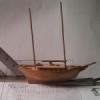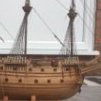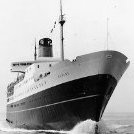-
Posts
1,829 -
Joined
-
Last visited
About tkay11

Profile Information
-
Gender
Not Telling
-
Location
Kentish Town, London, UK
Recent Profile Visitors
-
 tkay11 reacted to a post in a topic:
Simple, low cost, small thimbles
tkay11 reacted to a post in a topic:
Simple, low cost, small thimbles
-
Whenever I've used a centre punch, the thimbles mostly don't end up symmetrical and often squashed. Must be my technique. Oh dearie me. Tony
-
 tkay11 reacted to a post in a topic:
Simple, low cost, small thimbles
tkay11 reacted to a post in a topic:
Simple, low cost, small thimbles
-
 tkay11 reacted to a post in a topic:
Hull Planking Calculator
tkay11 reacted to a post in a topic:
Hull Planking Calculator
-
Very nice idea, George. Thanks. As it happens I have some old telephone wire which I will now set to use. Up to now I have used 1mm brass tubing with 0.5mm hole. I place a length of this in the lathe, close to the chuck, then make a tiny groove in the tubing. After that I simply use a jeweller's saw to remove it. It takes a lot of time, though. Tony
-
 tkay11 reacted to a post in a topic:
Simple, low cost, small thimbles
tkay11 reacted to a post in a topic:
Simple, low cost, small thimbles
-
Yes, I too have left them uncoloured, as I couldn't think of anything better to do. It just does leave them a little out of accord with the few wooden blocks I had already rigged. In my case, I'm not too bothered about that, as my Jacinthe is only for my pleasure and no one else's! Thanks for the analysis and description of your experiments - very useful as always! Tony
-
 tkay11 reacted to a post in a topic:
HM Schooner Ballahoo by georgeband - Caldercraft - Haddock drawings
tkay11 reacted to a post in a topic:
HM Schooner Ballahoo by georgeband - Caldercraft - Haddock drawings
-
 tkay11 reacted to a post in a topic:
HM Schooner Ballahoo by georgeband - Caldercraft - Haddock drawings
tkay11 reacted to a post in a topic:
HM Schooner Ballahoo by georgeband - Caldercraft - Haddock drawings
-
 tkay11 reacted to a post in a topic:
HM Schooner Ballahoo by georgeband - Caldercraft - Haddock drawings
tkay11 reacted to a post in a topic:
HM Schooner Ballahoo by georgeband - Caldercraft - Haddock drawings
-
 tkay11 reacted to a post in a topic:
Gary Thomas by J Snyder - 1:16 - William Atkin 25 foot Sloop
tkay11 reacted to a post in a topic:
Gary Thomas by J Snyder - 1:16 - William Atkin 25 foot Sloop
-
 tkay11 reacted to a post in a topic:
HM Schooner Ballahoo by georgeband - Caldercraft - Haddock drawings
tkay11 reacted to a post in a topic:
HM Schooner Ballahoo by georgeband - Caldercraft - Haddock drawings
-
 daHeld73 reacted to a post in a topic:
Fish-hooker by Ab Hoving - FINISHED - CARD - after af Chapman - how to scratch-build from paper
daHeld73 reacted to a post in a topic:
Fish-hooker by Ab Hoving - FINISHED - CARD - after af Chapman - how to scratch-build from paper
-
 JacquesCousteau reacted to a post in a topic:
Bateau de Lanvéoc by JacquesCousteau - Scale 1:32 - From Ancre Plans
JacquesCousteau reacted to a post in a topic:
Bateau de Lanvéoc by JacquesCousteau - Scale 1:32 - From Ancre Plans
-
 Paul Le Wol reacted to a post in a topic:
Bateau de Lanvéoc by JacquesCousteau - Scale 1:32 - From Ancre Plans
Paul Le Wol reacted to a post in a topic:
Bateau de Lanvéoc by JacquesCousteau - Scale 1:32 - From Ancre Plans
-
I love your build and learn from it. Just to add a slightly unnecessary or rather silly note, your interpretation is of course correct, but just to give the 'nautical' terms in translation this is "The frames are composed of futtocks having 88 moulded thickness and 122 sided". Moulded being the measure across the outer surface of a timber which is shaped to fit the overall hull shape, as determined by the moulds. Sided is the measure across the sides of timber at right angles to the outer or moulded surface. Tony
- 139 replies
-
- ancre
- Bateau de Lanveoc
-
(and 2 more)
Tagged with:
-
Thanks @JacquesCousteau, for the clarification. I had read your original post too quickly and thought you were referring to the Ancre translation! I had been so shocked by the translation you found that clearly I couldn't believe it. The English version provided by ANCRE reads as follows: "The rectilinear sternpost is fitted by a tenon into a mortice cut on the upper rear face of the keel, a small knee acting as the angular link between them." I have both French and English versions of the monograph and to my mind the English translation is fine. (The capitals for sternpost, by the way, are in the English version). I could never use an online translator for such technical work about boats of the age of sail. I agree they are next to useless other than in modern narrative passages where even there they just provide a guide to literal meaning. If you can't read the French it's definitely worth forking out for the ANCRE translation for the background history which I find most interesting, although as you're a craftsman you would easily get by just by using the lovely plan set. Sorry again for my confusion. Tony
- 139 replies
-
- ancre
- Bateau de Lanveoc
-
(and 2 more)
Tagged with:
-
Could you let me know where in the book you found these sentences? I have not found them in mine. Nor could I find "Let's move on to the description of the hull of the boat with various drawings". The photo you show at the start of the book cover is the ANCRE French original. The cover of the book I have has the words: "A Lanvéoc Boat, Small boats of the 17th - 18th Centuries, Surviving from the Middle Ages" followed by the author's names. Thanks Tony
- 139 replies
-
- ancre
- Bateau de Lanveoc
-
(and 2 more)
Tagged with:
-
I am sure that the more knowledgeable in the forum will have lots to say about this, but I thought I'd throw in Boudriot's instructions for the shrouds on the Jacinthe schooner of 1825. It does seem to say that all the shrouds were served as far as the catharpins. The measurements are in mm for the scale of the model at 1:48. "After fitting the softwood bolsters to the trestletrees the shrouds are got overhead in the following order for the foremast. The first eye has two short legs forming the fore winding-tackle pendants . The second has two legs , and forms the aftermost shrouds to port and tarboard. The third forms the remaining two shroud on the port ide. and the fourth the last two to starboard. In the case of the mainmast the order is as follows: first pair, pendants of the main winding-tackles; second pair, starboard hroud ; third pair, shrouds on the port side. The Ø of the deadeye is 270 (10") , Ø of the laniards 22. Winding tackle: fall Ø22 , blocks (upper blocks treble, lower blocks* double) 217 long (8"). The eyes of the shrouds and tackle-pendants are served with spun-yarn down as far as the catharpins. Ratlings Ø 8." Tony
-
I bought a refurbished Proxxon MF70 from Axminster at a great price and used it with aProxxon x-y table I had bought for a Proxxon MB140 drill stand. Although people have said that the mill is inefficient at drilling, I have found it so good at drilling that I now use it exclusively for drilling as well as milling. It is just a little slower, but that doesn't bother me. It is very accurate with the correct adjustments. My tungsten carbide drill bits have never broken with it when I use it as a drill. I had to adjust the MB140 to mill accurately with a finer height adjustment (see here on MSW) but could only use it as a mill with great care, which led me to the MF70. It's a great tool, much loved by European and other ship modellers with wonderful results. It is also much modded to include CNC, change of motor etc. I won't go that far as it is entirely satisfactory for my use. In fact I am such a poor modeller compared to the masters who use it that I will never use it to its full capabilities. I will never blame my tools for shoddy workmanship! It is certainly much less costly than the bigger mills and has lasted me several years so far. Anyway, everyone has their own requirements and I just thought to slip in my experience. Enjoy and master whatever your choice! Tony
- 53 replies
-
- Drill Press
- Milling
-
(and 1 more)
Tagged with:
About us
Modelshipworld - Advancing Ship Modeling through Research
SSL Secured
Your security is important for us so this Website is SSL-Secured
NRG Mailing Address
Nautical Research Guild
237 South Lincoln Street
Westmont IL, 60559-1917
Model Ship World ® and the MSW logo are Registered Trademarks, and belong to the Nautical Research Guild (United States Patent and Trademark Office: No. 6,929,264 & No. 6,929,274, registered Dec. 20, 2022)
Helpful Links
About the NRG
If you enjoy building ship models that are historically accurate as well as beautiful, then The Nautical Research Guild (NRG) is just right for you.
The Guild is a non-profit educational organization whose mission is to “Advance Ship Modeling Through Research”. We provide support to our members in their efforts to raise the quality of their model ships.
The Nautical Research Guild has published our world-renowned quarterly magazine, The Nautical Research Journal, since 1955. The pages of the Journal are full of articles by accomplished ship modelers who show you how they create those exquisite details on their models, and by maritime historians who show you the correct details to build. The Journal is available in both print and digital editions. Go to the NRG web site (www.thenrg.org) to download a complimentary digital copy of the Journal. The NRG also publishes plan sets, books and compilations of back issues of the Journal and the former Ships in Scale and Model Ship Builder magazines.










